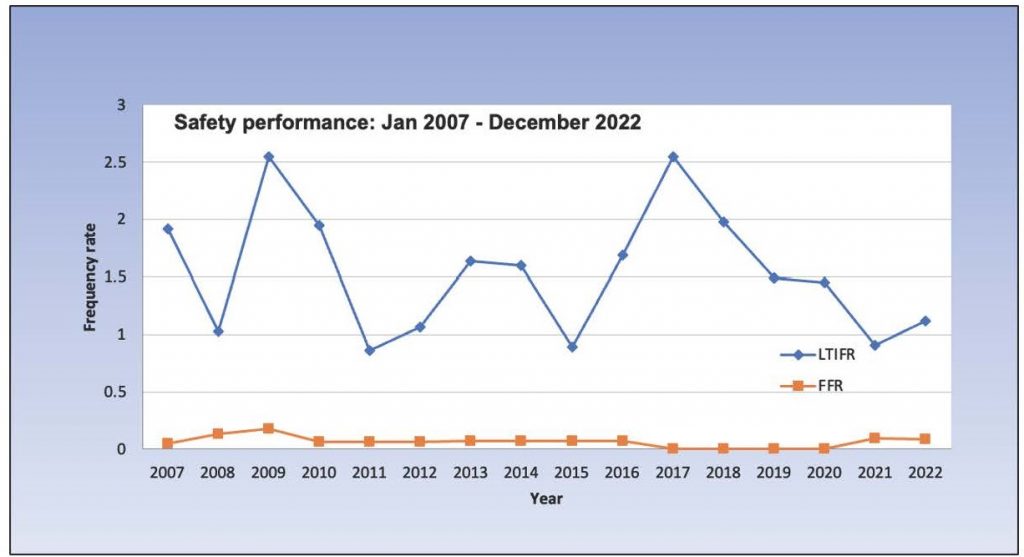We take health and safety (H&S) matters very seriously, and so do our members, as is evident in the implemented health and safety standards that are on par with international best practices systems. OHSAS 18 000 Occupational Health and Safety System; ISO 9001:2000 Quality Systems; DEKRA Safety Systems and NOSA Platinum 5 Star System have been implemented to assist in ensuring the health and safety of our members’ personnel – these systems are externally audited and certified biannually by independent accredited auditors.
Our members have indicated to have processes in place to test the health and safety of their staff, stating that all staff undergo medical examinations when going on site where some members conduct this annually and other members indicate to conduct this on risk-base. The majority of our members have indicated that sillicosus, TB, noise related hearing loss, and AIDS are included in their medical examinations. Where such diseases or conditions are identified, necessary authorities and medical practitioners are informed to ensure adequate treatment and monitoring of these cases.
HEALTH
The cement manufacturing process has inherent health hazards and a number of health problems have been associated with the cement industry in South Africa. Health problems in the production process are related to:
- exposure to dust;
- exposure to high temperatures;
- potential allergic reaction to powders; and
- noise exposure.
SAFETY
Injuries to employees have far reaching impacts on their families, which is why our ultimate goal is “Zero Harm”. Our member companies deem safety to be of the utmost importance. Collated member health and safety data is represented in the figure below.
Lost Time Injuries (LTIs) is the standard measure for safety system effectiveness and to aid comparison is often expressed as a Lost Time Injury Frequency Rate (LTIFR).

Safety performance: January 2007 – December 2022
LTIFR (Loss time injury frequency rate): Number of disabling injuries x 1 000 000 /Total Hours of employees (direct +indirect)
FFR (Fatality frequency rate): Number of fatalities x 1 000 000 /Total Hours of employees (direct +indirect)
Severity Rate (Annual) = The product of (Number of days lost due to the (LTI) loss time injuries) and a factor of 1 000 000) divided by the hours worked by direct and indirect workers.
CONTRACTOR SAFETY
Contractor safety poses a major challenge for many of our member companies who have found that the majority of accidents and injuries involve contractors. Companies are required to focus on the training and protection of their direct workforce, however it is assumed that contractors will be managed by the contract company.
Contractors are frequently used for cleaning and maintenance activities, especially during major planned plant shutdowns, where an additional workforce is required to meet tight schedules. As a result, contractors can be exposed to some of the higher risk activities, leading to an increased rate of accidents if the contractors are not fully trained and familiar with the plant and its hazards. CCSA believes that contractor safety awareness can be improved through induction training addressing the specific hazards and control measures related to cement manufacturing facilities. Furthermore, contractors need to be incentivised to deliver better safety performance.
APPROACH TO MANAGING SAFETY
Our member companies have found that a behaviour based approach to safety has worked well in addressing safety in their workforce. This is underpinned by safety leadership and ongoing training.
BEHAVIOURAL BASED SAFETY
Entrenching caring and safe behaviours into an organisation is a critical responsibility of both management and employees. It is behaviour that turns systems and procedures into reality. Optimal safety performance is dependent on how seriously organisations demonstrate that they value the safety of their employees. It is therefore imperative that management create a work environment that will motivate employees to work safely. A culture of blaming employees for incidents, accidents and injuries is counter-productive and can result in a culture of distrust and fear.
Behaviour-based safety is a process that ensures that safety becomes a value within organizations, by doing safety and not only “talking” safety. Managers and supervisors are required to perform their safety responsibilities on a daily basis.


